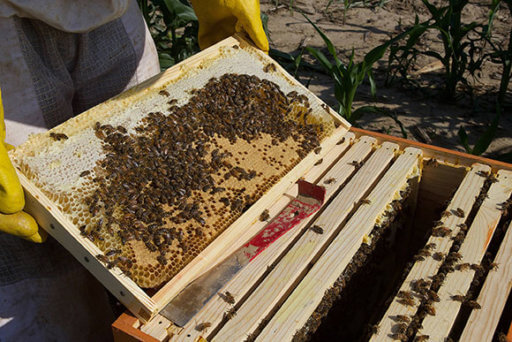
WEST LAFAYETTE, Ind. – Honeybees play essential roles in pollinating plants that humans and animals rely on for food. Declines in bee populations – including 20 percent of honeybee colonies per year in Indiana – threaten our food supply. Insecticide exposure, loss of flowering plants, and fewer nesting habitats, disease and parasites are all factors.
Beekeepers must, therefore, identify safe places to establish their colonies. A new online tool, developed by entomologists from Penn State University in partnership with Purdue University, the University of Illinois, the University of Minnesota and Dickinson College, helps them do just that.
At Beescape.org, beekeepers select a possible apiary location on a map. The Beescape model then provides a landscape score based on information about pollinator forage quality, nesting habitat quality and insecticide load for a 5-kilometer range.
“This is a tool for beekeepers to evaluate their field sites before, during and after they place colonies,” said Brock Harpur, a Purdue assistant professor of entomology and a collaborator on the Beescape project. “Protecting pollinators is vitally important, and we need to make data-driven decisions. This is a first step for pollinator managers to do that.”
Identifying ideal locations can be difficult since scientists are still learning about factors that affect populations and because bees travel so far from a colony or a nesting site to collect food.
“It has been nearly impossible for a beekeeper – or anyone interested in understanding what the bees in their backyards or farms are experiencing – to know what stressors their bees might encounter during their trips,” said Christina Grozinger, distinguished professor of entomology, director of Penn State’s Center for Pollinator Research and lead on the Beescape project.
Beescape is available in Indiana, Illinois and Pennsylvania, with more Midwest states expected to be added. Anyone who provides forage or refuge for pollinators is encouraged to use the website. Users can also share data on the health of their bees to improve the model used to calculate the landscape scores.
“Every state can have unique combinations of factors driving bee losses. We use the data generated by users to build specific models that take those differences into account,” Harpur said. “This is enabling us to make informed decisions about bee decline and to make predictions about where managed colonies are best suited. It’s smart beekeeping.”
Beescape is a partnership led by Penn State’s College of Agricultural Sciences, Center for Pollinator Research and Huck Institutes of the Life Sciences. Additional collaborators include Eric Lonsdorf, a lead scientist at the University of Minnesota’s Institute on the Environment, Harland Patch, a research scientist at Penn State, Doug Sponsler, a postdoctoral fellow at Penn State, Kate Anton, a research technician at Penn State, Melanie Kammerer Allen, a graduate student in the Ecology Program at Penn State, Adam Dolezal, an assistant professor at University of Illinois at Urbana-Champaign, and Maggie Douglas, an assistant professor at Dickinson College. The team collaborated with Azavea, a Philadelphia-based company which designs civic geospatial software and data analytics for the web, to develop the site.
The research was supported by funding from the U.S. Department of Agriculture’s National Institute of Food and Agriculture, and a grant from the Foundation for Food and Agricultural Research.
Writer: Brian Wallheimer, 765-532-0233, bwallhei@purdue.edu
Source: Brock Harpur, 765-496-6769, bharpur@purdue.edu